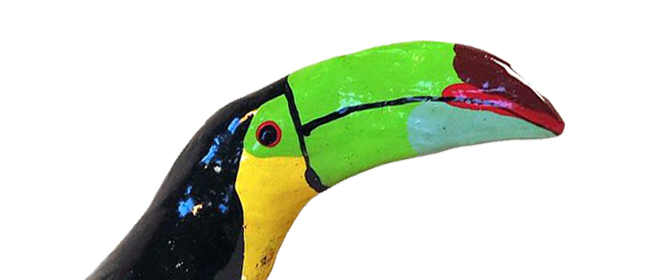
Christmas Island
“Christmas Island” – what kind of an island can that be? Do men with white beards and red bathrobes live there, constantly celebrating Christmas? Are presents exchanged every day? Does it never stop snowing there? Is this where heavenly peace reigns? The historian Robert Kluth has researched the history of the island for our blog.
I am curious so I enter the name in a search engine and read that Christmas Island is in the Indian Ocean south of Java; lowest temperature 23° C. (73° F.). This means no snow. It is surrounded by an azure blue sea, with high cliffs covered with palm trees. I begin to imagine a kind of Robinson Crusoe idyll. Presents beneath palm trees, not exactly your typical Christmas.
375 years ago, an English captain of the East India Company was sailing across the Indian Ocean. Not too much is known about William Mynors, that was his name, and his voyage. I have been unable to find a picture of him, but in my mind’s eye, I imagine an English captain with a weather-beaten face, maybe even with a white beard. He is lying in his bed and it’s 3:00 o’clock in the morning. A sailor storms into his cabin shouting “Land Ahoy!” Mynors brings the ship about and sees the island. The steep, tree-covered cliffs rise darkly from the sea. Later a trader will describe the island as “exceedingly pleasant, being covered with lofty trees”. Perhaps Mynors sails around the island, but finds no place to lay anchor. The captain asks what date it is, or maybe he already knows. Despite the warm weather, today is Christmas, 25 December 1643, just past Christmas Eve. Mynors thinks for a minute and then enters in his logbook that they have discovered an island and “… because it was Christmas Day we called it by the name of Christmas Island [sic].” What a beautiful name!
For Europe Christmas is an important festival, even today. Christmas tells us “something”, even if it is only “family celebration”. For a European captain and his crew far from home the name “Christmas Island” must have made them yearn for the homeland. After all, the ship was sailing through territory unknown to Europeans. To hear the name “Christmas Island” would make one think of snow, despite the tropical heat. It means something to every European, even if the island is so far away and the area so foreign.
What would the English explorers have said if they had known that the island also had other names? Far into the 19th century it was also called “Monij/Moni” or sometimes “Selam”, or “Celan Isle”. These exotic names can be found on maps from the 17th and 18th centuries. Jan Tent, an expert in place names, speculates that “Monij” probably comes from the Sanskrit word “muni” (holy man, silent) and refers to the silence and remoteness of the island. He believes that “Selam”, on the other hand, most likely derives from the Javanese word “sela”, meaning “precious stone”, given the ubiquitous steep rocky coastline of Christmas Island. Would the Englishman Mynors have accepted one of these names on 25 December 1643? The captain and his crew appropriated the distant island as something of their own, captivated it with a Christian European name.
Incidentally, the crew of the Royal Mary never set foot on the island. It was first in 1688 that the pirate and explorer William Dampier sent two small boats to land on the island. They returned with wood, birds and crabs. The place was uninhabited – no human lived on the island, which is about the size of 18,000 football fields. Until the 19th century it was not even clear whether there was one island or three at this place in the ocean. At this time there was still no independent geographical science with exact maps: the Europeans were still “discovering” the world, but not yet researching it (Jürgen Osterhammel). It was claimed that the names “Monij” and “Selam” stood for two other neighbouring islands, so that a map from the year 1707 shows three islands in this area, as can be seen on a modern Australian stamp.
In the 19th century the British began researching the island scientifically. Now it was about geography and geology. The scientists prepared precisely measured map material and established that there was only one island in this area and that it contained phosphate. In the 20th century the island finally became part of world history. In the Second World War Japan occupied the island in March 1942, and it was only returned to the United Kingdom in October 1945. On 1 October 1958 sovereignty over the island was transferred to Australia. In 2001 Australia erected the Christmas Island Immigration Detention Centre for the so-called Boat People seeking asylum. The background was the attempt of the Australian government to keep unwanted people away from mainland Australia. The boat arrivals headed for Australia were not even allowed to land, but were put in the camp. Christmas Island was an ideal place for this, as it is located 2500 km away from Australia in the middle of the ocean. It was virtually impossible to escape from the camp, which was surrounded by an electrically charged fence, with cameras monitoring every room. And so that the inmates could not apply for asylum in Australia, the island was promptly declared exterritorial. The people repeatedly protested against their situation and some died in the attempt. In October of 2018 the government finally closed down the camp.
And thus the beautifully named “Christmas Island” meets with the harsh reality of the Indian Ocean. The present-day inhabitants earn their living mostly by mining phosphate, where they certainly do not wear red bathrobes.
 © Privat |
Robert KluthRobert Kluth is a historian and exhibition curator and has worked for german and american museums. He taught history and philosophy at a Berlin grammar school. You can contact him via Twitter. |